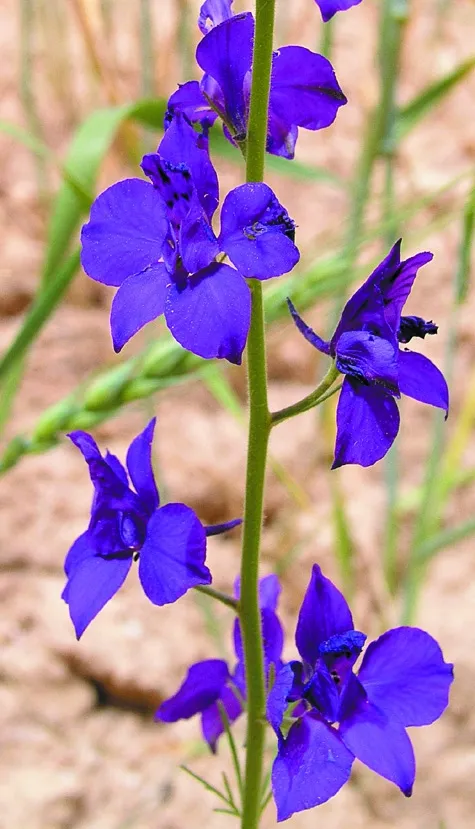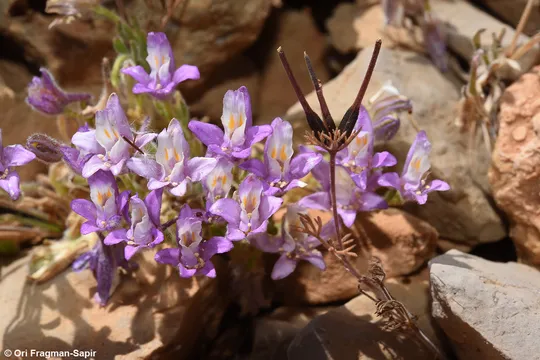Oriental Knight's-spur Common Poppy, Eastern Larkspur
Consolida hispanica

Consolida hispanica was once found in four regions in Israel: the Northern Negev, Negev Highlands, southern Judean Mountains and the Golan. It was first discovered in Israel in 1973 in the Golan basalt soil near Yahudiya. Another site was also found in the northern Golan. In 2002 Oz Golan discovered C. hispanica south of Arad (Wadi Kimrir), and since then he found additional sites near Mount Nafha in the Negev Highlands and in the northern Arad Valley. In 2003 Oz found large populations in the Mitspe Ya’ir area on the Ma’on Ridge. This population is stable and coexists in harmony with agriculture at the edge of traditionally cultivated fields.
Unirrigated land and rocky slopes with soil pockets in the semi-steppe belt. On the Golan it was collected in a southern-facing abandoned basalt field with basalt rocks – in habitats different than the main growth habitat in southern Israel. Attempts to find systematic differences between the southern and northern populations were unsuccessful.
The Consolida genus includes 43 species, which are common in the Mediterranean Basin and east of the Irano-Turanian area up to Central Asia. Twelve species grow in southern Europe, and circa 30 species grow the Middle East. All the species in the genus are annuals. The genus Consolida was once considered part of the genus Delphinium, which suggests that the genera are related. However, unlike Delphinium, whose fruit consists of three follicles, the fruit of Consolida has only one follicle; the species of Consolida are generally shorter than the Delphinium species, branching, and grow in arid areas. C. flava grows in the northern Negev on loess and sand, and is the only Consolida species in Israel with yellow colored flowers. C. incana is the most common species in the country. It has flesh-colored flowers, and grows in the semi-steppe zone. Compared to C. hispanica its flowers are sparse and its foliage hairy-glandular. C. pusilla grows on the Mount Hermon heights. It has purple flowers 7-10 cm in size.
• Consolida hispanica is known from only 6 sites spread over four regions and three different ecosystems are known – the high semi-steppe zone, the northern Negev Desert and the Mediterranean Golan Heights – (we are not aware of other similar cases in plants).
• Protected in the Yahudiya, Tel Krayot, Negev Highlands, Mount Avital, Mount Bental and Odem Forest nature reserves.
• The main site at Mitspe Ya’ir is threatened by construction and is in immediate danger.
A survey of the Yahudiya and Mount Odem regions should be conducted, to identify populations of Consolida hispanica. The Ma’on Ridge, Mount Nafha and Mount Arad should also be surveyed. Three different natures reserves, one in each ecosystem (with the largest and most typical populations), should be established after the sites have been located. The populations should be monitored every two years and compared. Mitspe Ya’ir on Ma’on Ridge should be declared a nature reserve immediately. The site has additional red plant species as well as other rare and important plants that have become extinct from Jerusalem and Gush Etzion as a result of development, urban construction and modernization of agriculture (Oz Golan, 2004).
Consolida hispanica has a broad range in the northern Mediterranean Basin and the Maghreb countries and in the western part of the Irano-Turanian region. In the Middle East it grows in most of the regions in Turkey, throughout Iran (except the south), in arid Syrian, and in Lebanon in the Anti-Lebanon Mountains.
Consolida hispanica is a beautiful, relatively rare annual species, which was discovered in the Golan in 1972 and the Negev in 2000.It grows in three ecosystems in two different sets of conditions: high steppes and the fringes of the desert in southern Israel and abandoned fields in the Golan Heights under Mediterranean-desert ecotone conditions. Its distribution in the Middle East suggests a similar duality.
גולן, ע.2004. הצמחייה המיוחדת ברכס מעון. כתב-יד ומצגת.
Current Occupancy Map
| 1000 squre meter pixel | 5000 squre meter pixel | 10000 squre meter pixel | |
|---|---|---|---|
| number of observations | 0 | 0 | 0 |
| in total pixels | 0 | 0 | 0 |
| Family | Ranunculaceae |
| Classification | On the endangered species list |
| Ecosystem | Semi-Steppe Belt |
| Chorotype | Mediterranean and Irano – Turanian |
| Conservation Site | Mitspe Ya’ir (Ma’on ridge) |
| Rarity |
1
3
6
|
|---|---|
| Vulnerability |
0
1
4
|
| Attractiveness |
0
2
4
|
| Endemism |
0
0
4
|
| Red number |
1
3.7
10
|
| Peripherality | N |
| IUCN category | DD EW EX LC CR EN VU NT |
| Threat Definition according to the red book | Vulnerable |
 Based on:
Based on:






